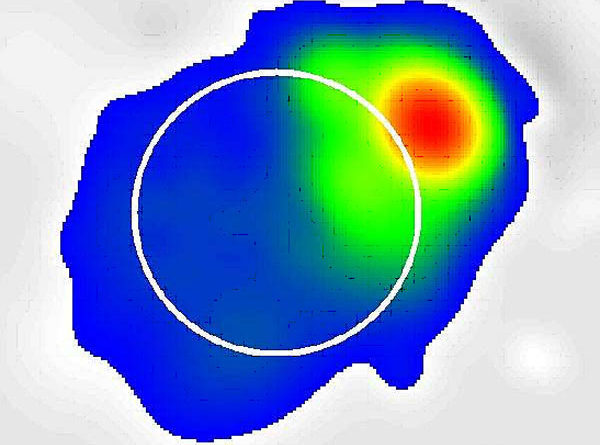Indian Scientists Make Deepest Radio Images of the Sun
Pune, India (SPX) Apr 16, 2019
The image shows the Sun during one of the powerful explosions on the Sun. The bright red area is the base of the explosion. The material ejected out from the explosion can often reach the Earth which can potentially affect communication and transmission systems. The white circle is the visible Sun.
The Sun is the brightest object in the sky which is probably the most studied object. Surprisingly, it still hosts mysteries which scientists have been trying to unravel for decades, for example, the origin of coronal mass ejections which can potentially affect the Earth. Led by Dr. Divya Oberoi and his Ph.D. students, Atul Mohan and Surajit Mondal, a team of scientists at the National Centre for Radio Astrophysics (NCRA), Pune, India, have been leading an international group of researchers to understand some of these mysteries.
The Sun has some of the most powerful explosions in the solar system. Their possible impacts on Earth include electric supply blackouts, satellite damage, disruption of GPS based navigation, etc. Hence, it is becoming increasingly important for our technology reliant society to understand and be able to predict space weather reliably.
Turns out that this is a really hard problem. The source of the energy for these massive explosions are the magnetic fields in the Sun’s atmosphere, the corona, and they are notoriously difficult to measure. Observations in radio wavelengths are best suited for this problem, but even there, this information is very hard to extract.
“The Sun is a surprisingly challenging radio source to study,” explains Dr.
Oberoi. “Its emission can change within a second and can be very different even across nearby frequencies. In addition, the radiation due to the magnetic fields is so weak that it is like looking for the feeble light from a candle in the beam of a powerful headlight. On top of this, seeing coronal emission at radio frequencies is a bit like looking through a frosted glass, which distorts and blurs the original image.”
A new telescope extremely well suited for solar studies has recently become available: the Murchison Widefield Array (MWA) in Australia. Divya Oberoi of the National Centre for Radio Astrophysics, in Pune, has been leading the international solar science collaboration of the MWA since its very inception. He and his Ph.D. students Rohit Sharma, Atul Mohan and Surajit Mondal, along with some international collaborators, have been working to build the tools and techniques to uncover the mysteries of the Sun using the MWA data.
To keep up with the rapid changes in the solar emission it is necessary to make images of the Sun at every half-a-second interval and also at hundreds of closely spaced frequencies, totaling to about a million solar images every hour. They recently successfully developed an automated software pipeline for making these images.
“The solar images from this pipeline also offer the highest contrast which has ever been achieved, and are a big step towards understanding space weather,” says Surajit Mondal, the lead author this study.
This pipeline is called ‘Automated Imaging Routine for Compact Arrays for the Radio Sun’ or AIRCARS. The contrast of the images from AIRCARS are much better than the best solar images available. These high contrast images have already yielded their first discovery – a group of weak radio bursts.
This work has also led to the very exciting discovery of oscillations in the size of the radio emitting region and its brightness.
In the words of Atul Mohan, the lead author of this study, “These findings challenge the conventional wisdom of these oscillations arising in the local magnetized plasma and point to a new phenomenon operating deep down at the base of the solar atmosphere.” These images have also led to a technique for estimating, for the first time, the details of exactly how passing through the corona distorts the radiation passing through it.
Both these studies have recently been accepted for publication in the Astrophysical Journal.
The other members who contributed to this work are Colin Lonsdale and Leonid Benkevitch, both from the Massachusetts Institute of Technology, USA; John Morgan from Curtin University, Australia; Iver Cairns from University of Sydney, Australia; and Meagan Crowley from University of Massachusetts, USA.
Courtesy: Spacewar

